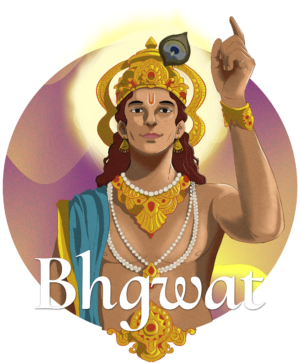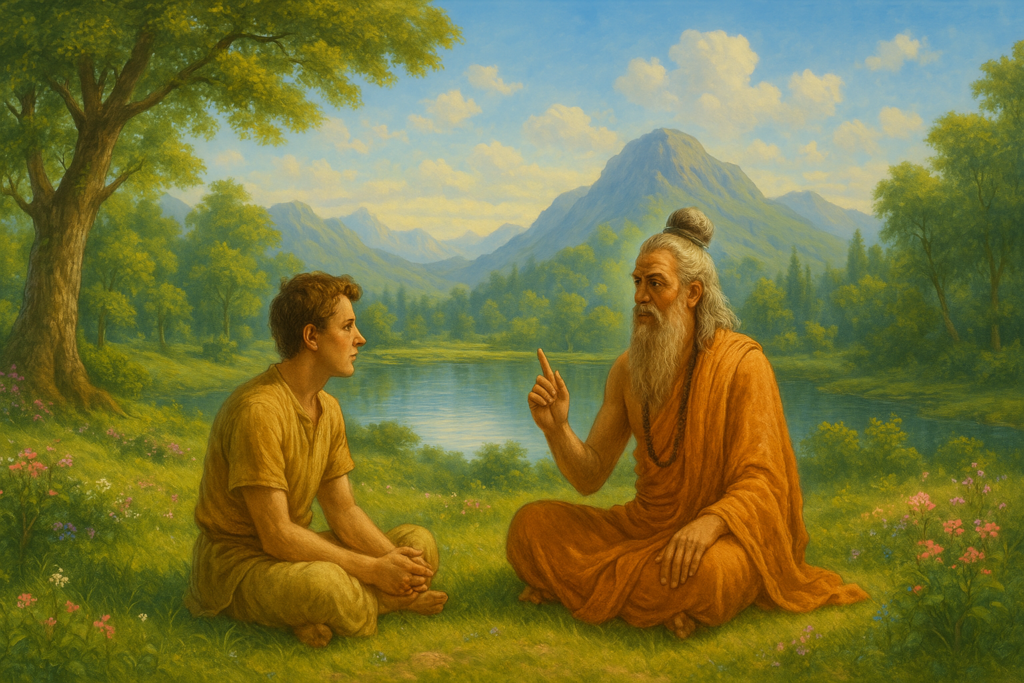Philosophy vs Devotion: What Sets Gita and Bhagwat Apart?
An Engaging Journey Through the Soul of Two Timeless Scriptures
Long ago, in a quiet ashram nestled near the banks of the sacred Ganga, a curious young seeker named Rishi sat before his wise Guru under a neem tree. His heart was full of questions.
“Guruji,” he asked with folded hands, “I have read both the Bhagavad Gita and the Bhagwat Mahapuran, but I am confused. One speaks of action and detachment, while the other makes me cry tears of love and longing for Krishna. Why are they so different?”
The old sage smiled, as if he had been waiting for this question all his life. “Ah, Rishi,” he said gently, “you’ve touched upon the very pulse of Hindu spirituality — the journey from philosophy to devotion. Let me tell you what sets the Gita and the Bhagwat apart… and yet, how they complete each other.”
📖 The Bhagavad Gita: A Dialogue of the Intellect
The Bhagavad Gita, found in the Mahabharata (Bhishma Parva, chapters 23–40), is a divine dialogue between Lord Krishna and Arjuna, set on the battlefield of Kurukshetra. The setting itself is symbolic: life is a battle, and we are all Arjunas — confused, fearful, and seeking direction.
Krishna speaks as a teacher — a philosopher-king, unraveling Jnana Yoga (path of knowledge), Karma Yoga (path of action), and Dhyana Yoga (path of meditation). In Chapter 2, Verse 47, Krishna famously declares:
“Karmanye vadhikaraste ma phaleshu kadachana”
(You have a right to perform your prescribed duty, but you are not entitled to the fruits of action.)
Here, Krishna encourages dispassionate action — not inaction, but detached action rooted in wisdom.
The Gita is Upanishadic in nature — a condensed version of the Vedic philosophies. It answers: Who am I? What is my duty? What is the nature of the Self? It is a scripture for the intellect — like a lighthouse guiding the lost through logic, analysis, and inner realization.
📚 The Bhagwat Mahapuran: A Symphony of the Heart
Now, contrast this with the Shrimad Bhagwat Mahapuran, especially its Canto 10, where Lord Krishna’s childhood, youth, and divine leelas (playful pastimes) are beautifully narrated. This text doesn’t demand reasoning — it evokes feeling.
When devotees read about Krishna stealing butter, dancing with the gopis, or lifting Govardhan Hill, something happens. Tears flow, the heart melts — not from philosophy, but from bhakti (pure devotion). The Bhagwat speaks directly to the emotional and spiritual core.
In Canto 1, Chapter 2, Verse 6, it says:
“Sa vai puṁsāṁ paro dharmo yato bhaktir adhokṣaje”
(The supreme occupation for all humanity is that by which men can attain to loving devotional service unto the transcendent Lord.)
Here, the Bhagwat emphasizes that devotion is the highest path, surpassing ritual, knowledge, and action.
🧭 Different Roads, Same Destination
Guruji leaned closer to young Rishi and whispered, “Rishi, one text shows you the map, the other sings to your soul.”
“The Gita prepares your mind. It removes ignorance, calms the ego, and sets the foundation. But the Bhagwat? Ah! The Bhagwat is the journey of the heart — where the jnani becomes a bhakta.”
Indeed, the scriptures themselves point toward this transition.
In the Gita (18.66), Krishna concludes His teachings by saying:
“Sarva-dharmān parityajya mām ekaṁ śaraṇaṁ vraja”
(Abandon all varieties of duties and simply surrender unto Me. I shall deliver you from all sinful reactions. Do not fear.)
This is a bridge to bhakti. Krishna ends the Gita with surrender — foreshadowing the essence of the Bhagwat.
🌸 From Head to Heart: The Spiritual Evolution
The ancient sages knew that philosophy is important — it anchors the seeker. But love is transformative.
In the Bhagwat Mahapuran (1.5.10), Narad Muni says to Vyasa:
“Na yad vacaś citra-padaṁ harer yaśo… tad vāyasaṁ tīrtham”
(That literature which does not glorify the Lord is like a place of pilgrimage for crows.)
In short, knowledge without devotion is dry. True wisdom blossoms into love.
✨ Key Differences at a Glance
| Aspect | Bhagavad Gita | Bhagwat Mahapuran |
|---|---|---|
| Tone | Philosophical, Rational | Emotional, Devotional |
| Focus | Duty, Detachment, Self-Realization | Love, Surrender, Divine Leela |
| Goal | Liberation through knowledge and action | Liberation through loving devotion |
| Krishna’s Role | Teacher, Philosopher | Beloved, Divine Child, Flute Player |
| Audience | Seeker of truth | Lover of God |
🌸 The Final Word
As the sun set behind the Himalayas, Guruji concluded, “Rishi, the Gita teaches you how to stand strong in life. The Bhagwat teaches you how to dance in divine love. One prepares you for surrender, the other celebrates it.”
Rishi smiled, his confusion slowly fading into calm. He understood now — the Gita and Bhagwat are not opposing paths, but complementary steps in a single divine journey. From the mind to the heart, from clarity to ecstasy, from action to surrender.
And just like that, a new chapter of understanding began for the young seeker — and perhaps, for you too.



